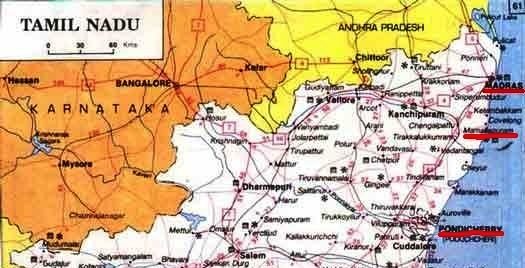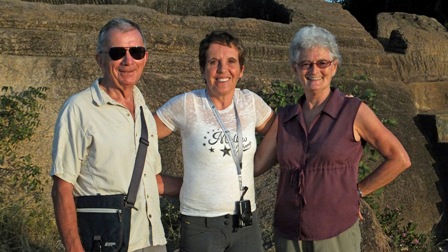Southern India Revisited
Episode 1: Mamallapuram; Chance Encounters

 Click the photo above of Ray & Jeanne with Jetja to see an album of photos. Close the window to return to this page |
Read Next: Episode2: Pondicherry
|
February 1-3, 2013, Mamallapuram, India
“Ray, that woman who just passed me looks an awful lot like Jetja, from the OBC in Ottawa. I think a group of bicyclists just arrived and one of them had a Canadian flag luggage tag on his backpack”. We went racing after the group who were walking next to some of the Cave Temples in Mamallapuram, a small tourist town about 2 hours south on the bus from Chennai. Sure enough it was Jetja (pronounced the Dutch way ‘Yetcha’). We had flown from Colombo, Sri Lanka, the previous afternoon and taken the bus to Mamallapuram that same morning. The bicycle tour group had just spent a few days in Chennai and had also arrived in Mamallapuram that same day. The bicycle group was only staying one night in town before starting on a tour of Southern India by cycling to Pondicherry the next morning. Jetja introduced us to some of the others in the group, mostly from Ottawa and Vancouver. The word spread that fellow Ottawa cyclists were around. Paul Meisen, a fellow who used to bicycle with Ray until his job moved him to Montreal, came running up to us to say hello. We walked and talked with them to the top of a the Cave Temple Hill to see the sunset before wishing them a safe journey. It doesn’t matter what country of the world you are visiting anymore. The chances are high you may meet someone from your home, or at the least, someone within that magic seven degrees of separation.
Mamallapuram, population just
12,000, is the biggest tourist town we have been in for a long time.
Ray said it reminded him of the Backpacker Quarter of Bangkok.
Apparently it was on the Hippy route during the 70s and has stayed
popular. You can buy lots of clothing favoured by backpackers and
lots of stone carvings, from small Hindu icons to huge lawn
ornaments. The town has a long sandy beach, shared by local
fishermen and lines of restaurants and guesthouses. It didn’t appeal
to us as a swimming beach as the water was less than clear and the
surf can make swimming challenging.
I had my first run in with an
Indian cow in Mamallapuram. A garbage truck passed us as we walked
down a narrow street. Instead of watching my feet, I watched where
the truck was going and stepped in a big pile of very fresh cow
dung. What a mess. I had to return to our room to wash all the muck
off my shoe. I should be in for several days of good luck after that
incident.
We are finding out that the
transportation system in India is not much better than our
experience on our last trip to India in 2000-2001. Our bus trip from
Chennai worked out well only because we got a taxi part way to get a
direct bus to Mamallapuram. Otherwise we would have had to transfer
to an already packed bus and stand for the 2 hour ride. A reserved
seat on a train sounded good for later in our trip. We thought we
would be proactive and book ahead of time. The two routes we
inquired about were both full and had long wait lists. We have
websites to try to get one of the few last minute tickets that are
released one or two days before departure, otherwise, it is back to
the buses.
A day trip to a bird sanctuary just 57 km from Mamallapuram was crossed off our list. There is no inexpensive day tour from Mamallapuram, no guide at the sanctuary, just a place to observe the waterfowl, and the cost for a car and driver for a 1 ½ hour drive each way was out of our budget range. Tiruvannamalai has one of the top five temples in Tamil Nadu. It sounded fascinating. Unfortunately the last 70 km of road leading to the town is torn up and we couldn’t find anyone willing to brave the drive to get there. Oh well, we have plenty of other places to visit this month. Mamallapuram is certainly a favourite place for French tourists, perhaps because of its proximity to Pondicherry, once a French Protectorate. There are several stores and restaurants run by French proprietors and several of the local guides speak French. All that means the food is very good but we have to search for an Indian restaurant that will prepare spicy dishes for us. Neither French nor Germans like spicy food. Southern India means Hindu temples. Talasayana Perumal Temple was a mixture of old and new. There was an ancient ruin next to a slightly newer temple carved with scenes from the Ramayama but left unpainted. Bells were ringing and we could hear prayers being intoned. We paid a fee of Rs 1 (about 2 cents) and went in. This was the end of the day. Temple priests were draping statues with clothes, as if putting them to bed for the night. One man was even spreading gold cloths over a large reclining Vishnu with four arms. Two men were seated on the floor reciting the prayers. One was reading aloud from an old tattered book, the other was using an eReader; a sign of the times. Ray was loath to disturb them by taking a photo and I didn’t have my camera with me. Ray and I took advantage of the beautiful fabrics sold in many of the shops in town to have new night shirts made. I especially like the silks sold in Asian countries as the fabric is perfect for travelling. It is light weight, dries quickly, folds into a tiny package and breathes. The tailors in the store we chose were able to replicate clothing we had with us within a very short time. The temples of Mamallpuram were given World Heritage status in 1984. Archaeologists have been working for the past century to uncover temples from years of accumulated sand. The ancient temples date from the 6th– 9th century AD. The Shore Temple sits overlooking the ocean, protecting the maritime interest of its builder, the Pallava Kings. The temple is not large but the proportions are excellent. There are two stepped spires covered with carvings of excellent quality, although the abrasive action of sand and saline winds is taking a toll.
On everybody’s must see list is
Arjuna’s Penance, a huge tableau featuring elephants, a series of
snakes filling a crevasse once flowing with water representing the
Ganges and hoards of celestial beings floating in space. The hill we
visited the first day to view the sunset has a collection of cave
temples and tanks to store water for bathing and drinking, cut into
the boulders strewn over the hill. They honour gods to protect all
their worshippers. There was even one boulder, called the Butter
Ball that everybody likes to pose under like Hercules lifting the
world. We managed to visit most of them over the course of the
weekend, snapping lot of photos that you can see on Picasa.
The Five Rathas, shrines
representing chariots used in festival processions, are a favourite
of everybody. The monuments, each carved out of a single rock
boulder, have a life-sized carved animal next to them that is the
mount of the Hindu Gods.
One of the changes we have noted
is the increase in Indian tourism. Bus loads come, especially on the
weekends, to visit the same towns that have enticed foreign visitors
for years. We were in the minority for our visit to Mamallapuram on
Saturday and Sunday and the Indian tourists were just as curious
about us as we were about them. We ended up chatting to several
groups and were even included in a few of their souvenir photos.
|
Next: Episode2: Pondicherry
Read Sri Lanka 2013
Return to India 2013 Intro
Return to India Chronicles 2000-2001
Return to Travels
or Introduction